Lockwood
Custom Optics at the
|
The road less traveledIt was time for a change of route to get to Okie-Tex. For the last 10 years I had been driving the same route, across I-70 to just past Salina, and diagonally down across Kansas to the southwest by various state routes, mainly Kansas 66, to Boise City, spending as little time as possible on the generally bumpier Oklahoma roads and more on the generally smoother Kansas roads.However, this time I wanted a less trafficked route that was still enjoyable to drive. So, I headed west on I-72 to Hannibal, MO, and continued west on Missouri 36, which is practically an interstate most of the way across northern Missouri. You can take 36 all the way to Denver, if you wish, but I turned southwest at St. Joseph, MO on route 59, crossing into Kansas at Atchison. Suddenly the Atchison, Topeka, and Santa Fe Railroad name made sense to me because I knew where they all were! I stayed on 59 into Topeka, took I-335 and I-35 most of the way to Wichita, avoided some interstate construction by taking 254 and I-235 around Wichita, and stopped for dinner on the west side of that city. The first day's drive concluded with a drive west from Wichita on 400, ending just under two hours later in the now rebuilt Greensburg, KS. See my 2007 Okie-Tex Article for a few photos of the town showing the (at the time) recent damage from a massive F5 tornado. Today it looked like nothing much had happened, and I checked into a fairly new Best Western and settled in for a nice night's sleep. The new route had the desired effect or I did something correctly, because I was not frazzled, stressed out, or tired when I got to the hotel. That was nice. Perhaps the one energy drink that I had slowly sipped for about three hours after lunch had helped too, I'm not sure. 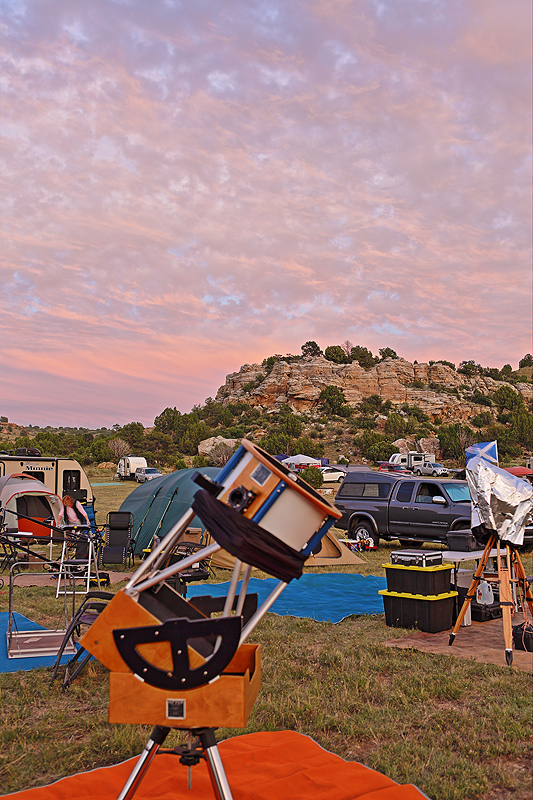 The next morning I found light
rain falling outside, and I had heard a bit of thunder overnight but it
hadn't stopped me from getting a good night's sleep. I
welcomed the car wash as I headed westward and slightly southward on
the fast Kansas roads. There was only one major group of cars
and trucks to pass, and that slowly sorted its way out and I was free
to drive unimpeded. Soon I was taking a slight
left onto Kansas 54, onto 160 at Plains, and finally short drives on 83
(which was particularly scenic where I was on it) and 51 took me to
Hugoton, where I met up with the very familiar Kansas 56 that I had
traveled many times before, and which would take me to Boise City.
As is tradition, I stopped in Boise City to get a
chicken salad from
Subway, and I took it out to the site to eat there. The next morning I found light
rain falling outside, and I had heard a bit of thunder overnight but it
hadn't stopped me from getting a good night's sleep. I
welcomed the car wash as I headed westward and slightly southward on
the fast Kansas roads. There was only one major group of cars
and trucks to pass, and that slowly sorted its way out and I was free
to drive unimpeded. Soon I was taking a slight
left onto Kansas 54, onto 160 at Plains, and finally short drives on 83
(which was particularly scenic where I was on it) and 51 took me to
Hugoton, where I met up with the very familiar Kansas 56 that I had
traveled many times before, and which would take me to Boise City.
As is tradition, I stopped in Boise City to get a
chicken salad from
Subway, and I took it out to the site to eat there.My car was stuffed full of tripods, my 14.5" f/2.55 telescope, a cooler with food in it, beer for tasting, and some beverages to take to a friend in New Mexico. We had decided to cook some of our own food at this star party, so I had pork chops, veggies for grilling, and some other ingredients and jars of sauce for an Indian food dish that I planned to make in a crock pot. I dropped the pork off at a friend's B&B near the site (with a small fridge), and headed on into the gate to see who had arrived already. I found Ed and the taped-off area that he had claimed for the Lockwood Village, as others have named it, the area where I try to get friends and clients to set up so that I can mooch off of their telescopes for the week. Well, not really, we just set up together because we enjoy it and enjoy each other's company. Besides, this time I had actually brought a telescope, my 14.5" f/2.55 Newtonian, which had last been to Okie-Tex in 2009, exactly 10 years prior. That year it made its public debut and Al Nagler gave it a thumbs up. To see that, scroll halfway down in my 2009 Okie-Tex Article. I had lunch under Tara's dome tent (a.k.a. the "Tara-Dome"), dropped off my telescope parts at Ed's trailer, got my bunk made up in the staff bunkhouse, and then I came back down to the field for our first 3pm beer tasting. Throughout the week we all outdid ourselves and brought some great vintages and just generally excellent craft beers. Our first meal was dinner, which was a salad and Ed's excellent masala and some flatbread. It really hit the spot. We're back - and it's cloudy - oh wait it's clear!As the sun got low, I took a shower and then assembled my 14.5" f/2.55 on one of the Meade field tripods that I normally use for optical testing in my shop. I used the 1/2"-threaded pin from my Equatorial Platforms platform, and threaded through a stout 14.75"-diameter aluminum disk and into the threaded top of the tripod. I ended up with an aluminum disk "ground board" on top of the tripod. I bolted three teflon pads to the aluminum disk, and the rocker box for the telescope simply slipped over the pin and sat on that. It worked superbly and was sturdy and didn't shake at all.The photo at right shows my scope set up under a partly cloudy sky around sunset on Saturday. As it got dark, we sat outside under the partly cloudy sky and waited for it to clear. The wind was quite strong, and we soon took shelter from it in Ed's trailer where we continued a limited amount of tasting in hopes that it would clear. After an hour or so, we stepped outside and found a gloriously clear sky. After being deprived of such a sky for two years, we began observing despite the wind. Neither my 14.5" (which I originally called "The Paracorr Buster", but now has become known as "Stubby") nor Ed's 24" f/2.75 (a.k.a "Elvira, Mistress of the Dark") were affected by the wind. However, the rest of the observing field, except for imagers with wind-blocking structures, was generally shut down and people had turned in early. We observed late into the night until we got tired due to not being used to staying up late. A good night of sleep followed. On Sunday, before lunch, I headed to the B&B, which had a grill. I grilled pork chops and squash planks for lunch (and we had enough leftovers of both for a lunch on Monday just after Allan arrived). I worked on my talk until tasting time on Sunday afternoon. Soon it was time for dinner, which was chicken-fried steak. It was quite good, as usual. This is the one time per year that I have chicken-fried steak. The weather remained nice, and Sunday night was clear and less windy. I spent quite a bit of time taking photos of a variety of objects through my nightvision (NV) unit. Some objects were already quite low in the southwest as it got dark, so I hastily shot those objects before they set behind the ridge. The next night I even photographed an object as it set behind the ridge, making for an interesting shot of some nebula complex in Scorpius. 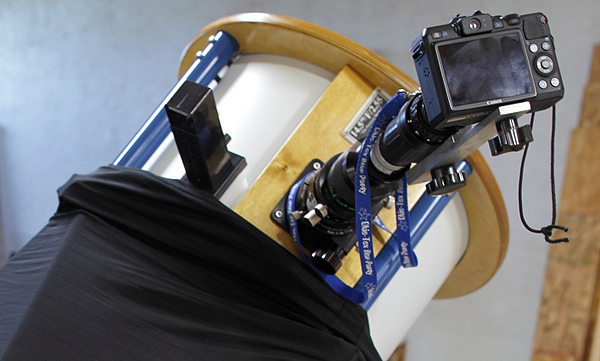 So how did I shoot photos through the nightvision monocular? With my phone? No. My phone camera is junk. The photo at left shows the simple, but custom, bracket that I made to hold my Canon G15 point-and-shoot camera at the proper distance from the ocular of the nightvision (NV) unit, which is then attached to a TeleVue eyepiece, usually a 41mm Panoptic for this trip, and the eyepiece is placed into a Paracorr 2 or the focuser on a SIPS, depending on the telescope. My NV monocular was obtained from Tactical Night Vision Company. The adapter that connects the NV unit to the eyepiece is also made by TNVC. The stack of equipment becomes fairly tall/long, so SIPS or sturdy focuser from Starlight Instruments is important to avoid flexure. My 14.5" doesn't have a SIPS yet, but it does have one of their focusers. (See my article about the SIPS if you have questions.) My home-made bracket proved quite effective. Camera and nightvision (NV) unit both have 1/4-20 threaded holes in them, so two threaded knobs conveniently attach the bracket to both. The bracket is machined to sit against the NV unit snugly and to align to its optical axis. The camera can rotate on its mounting stud, but it is aimed quite easily to center the image that it sees and then it is snugged up to prevent movement. For a future improvement, I would like to come up with a quick-release mechanism so that I can more easily install and remove the camera. Threading the knob into the NV unit is a bit tricky in the dark, and it is generally easier to find objects by looking in the NV eyepiece. So, it would be nice to be able to more quickly switch between the camera and visual observing. It should be possible to loosen a knob and just swing it off to the side, but I have not yet tried this and it will probably act like an arm and cause the NV unit to rotate so that the camera is closest to the ground. I will definitely consider other options in the future. Note that the NV unit, due to the 1X lens permanently attached to the front of it, has a narrower field of view than the eyepiece. So, it only sees the central part of the field of view of the eyepiece. This yields about a 1.5-degree-wide field of view by my crude estimation. I fought a bit with the operation of the camera - I had installed CHDK, a third-party firmware enhancement package, but I couldn't figure out how to control things in the way that I wanted, so I went back to the camera's normal operating firmware and used a higher ISO. I will see what I can figure out in the future, but it may be time for a more modern small camera that may have lower noise and may just generally work better. I also had trouble focusing the telescope because I couldn't zoom in on the live view, and I never managed to read the manual in search of how to do that. Therefore, not all images are equal in focus quality - some are better than others. Now that the disclaimers are out of the way, below are six photos of various objects with descriptions, taken that Sunday night. These objects were in the southern sky. All six images just below are taken with my 14.5" f/2.55 Newtonian (with FeatherTouch focuser), Paracorr 2, 41mm TeleVue Panoptic, 2" Baader 7nm h-alpha filter (installed on the eyepiece), Canon G15 camera, TNVC eyepiece-to-NV coupler/adapter, and TNVC TNV-14 white phosphor filmless nightvision monocular. (TNV-14 is TNVC's part number for the unit, but this type of NV monocular with non-removeable front lens is also generically referred to as a PVS-14.) To clarify, these images as seen through a narrowband h-alpha filter, and though the images appear slightly green due to the camera's imperfect white balance, they are from a white phosphor nightvision unit that basically looks black and white to the eye. The camera's settings were f/1.8 to f/2.0, ISO 1600. Exposure times were determined by the camera, but were all one second or less depending on object brightness, and the camera auto-focused on the image. 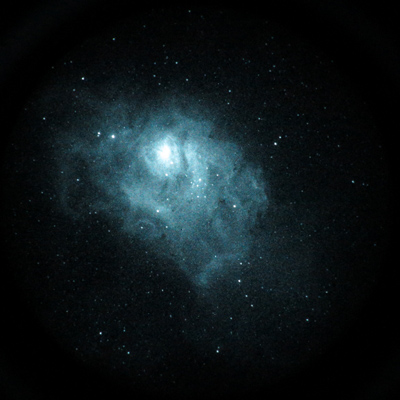 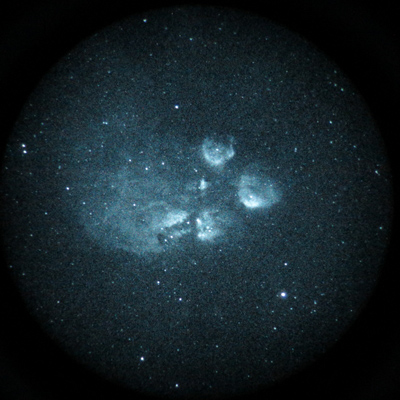 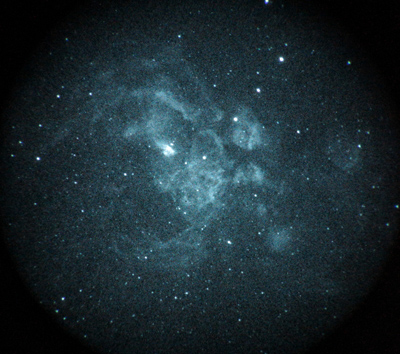 (Above, left) Lagoon Nebula, M8, (center) Cat's Paw Nebula, NGC 6334, (right) Lobster Nebula, NGC 6357. 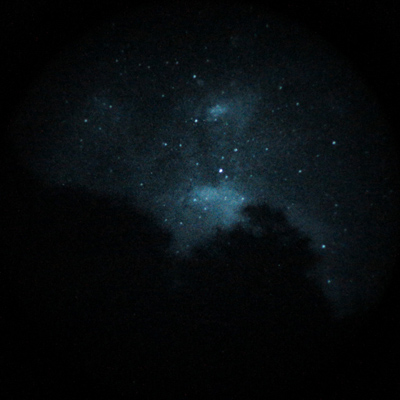 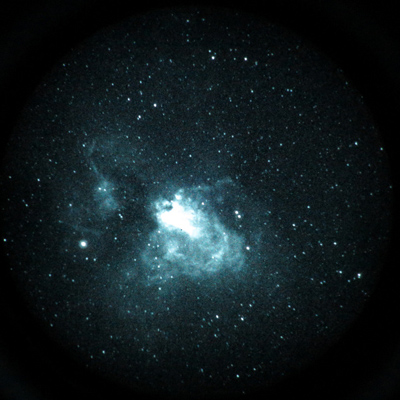 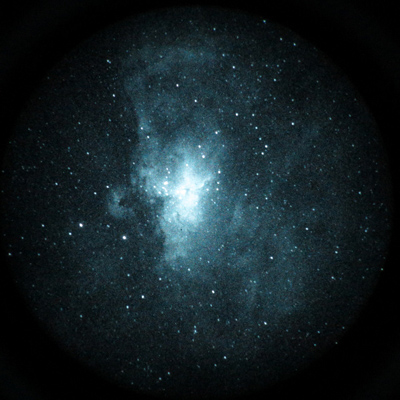 (Above, left) Unknown nebula setting over the southwest ridge, possibly RCW 126 according to S&T Pocket Sky Atlas, (center) M17, Eagle Nebula, (right) M16, note the small dark region in the center a.k.a the Pillars of Creation. Those objects are most of the large nebulae in the southern part of the Okie-Tex sky. I was happy to catch them all. Visually, the images showed a bit more subtle detail and bright areas and bright stars are not quite so blown out, but the photos are reasonably faithful to the visual view. It was addictive to scan around and just see what happened into the eyepiece. The Cats Paw and Lobster Nebulas were found in this manner, as was the unknown nebula (possibly RCW 126) setting over the trees on the ridge, somewhere in Scorpius. Next, I turned my telescope to the h-alpha regions high above in Cygnus and on up into the winter Milky Way rising in the northeast. I realize now that I neglected to image the California Nebula, which was detailed and stretched over several fields of view, but I caught many other objects. I also didn't shoot the Elephant Trunk in IC 1396, but we viewed it a number of times in both telescopes. 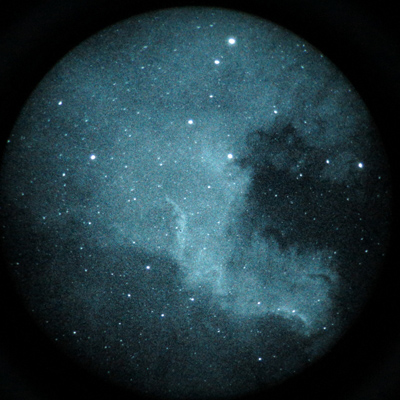 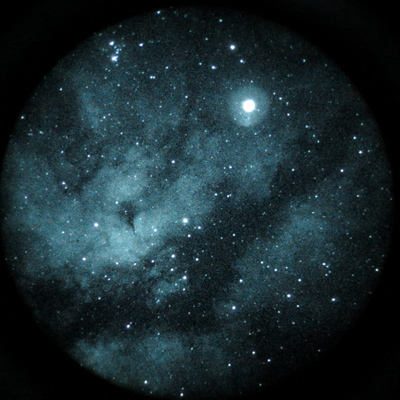 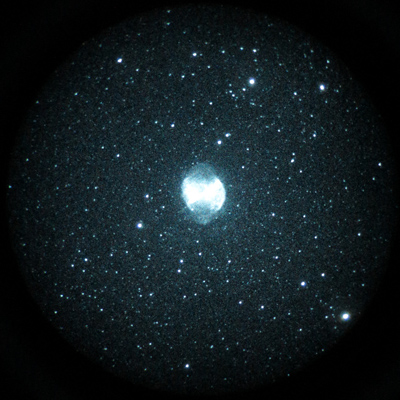 (Above, left) North American Nebula, NGC 7000, (center) bright star is Sadr, IC 1318, IC 1311, (right) M27, the Dumbbell Nebula. The M27 image above right and the three images below are from Ed's superb 24" f/2.75, known as Elvira. She is a beautiful telescope with countless features, all designed and built by Ed himself. His filter wheel made filter comparisons quite simple. I switched between a Celestron UHC/LPR filter, a Baader 7nm h-alpha filter, and Ed's Astronomik 6nm h-alpha filter to see what various objects look like. (I will post the results of those comparisons on my Nightvision page and link to that here in the future.) Below, the left two images at through a narrowband h-alpha filter, but the galaxy image at right is unfiltered. 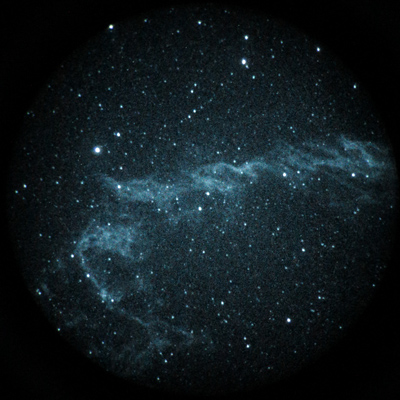 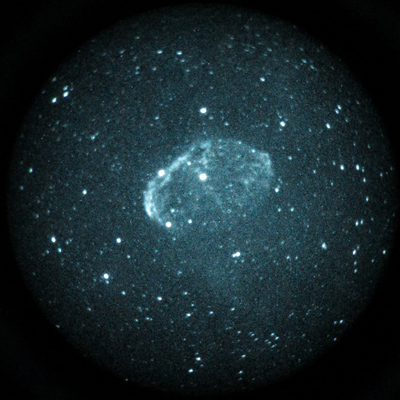 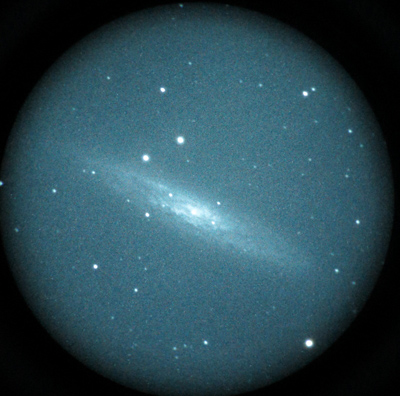 (Above, left) northern portion of the Veil Nebula, NGC 6995, NGC 6992, (center) Crescent Nebula, NGC 6888, (right) Sculptor Galaxy, unfiltered, NGC 253 showing loads of detail. Finally, here are three more filtered images from my 14.5" f/2.55. These are objects that are in the northeast sky in the evening at Okie-Tex. 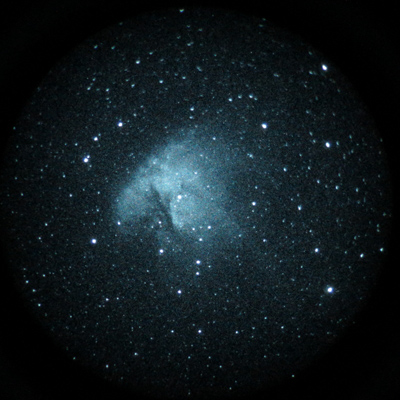 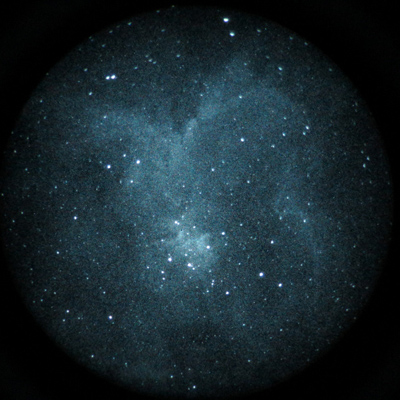 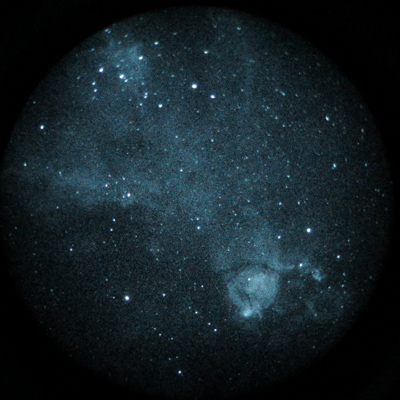 (Above, left) The Pacman Nebula, NGC 281, (center) upper part of the Heart Nebula, IC 1805, (right) the bottom part of the Heart Nebula, IC 1795, and IC 896. 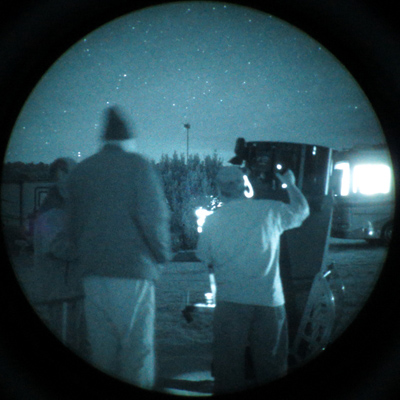 You might be
wondering - how does a 41mm Panoptic work in such a fast telescope?
Isn't the exit pupil too large? You might be
wondering - how does a 41mm Panoptic work in such a fast telescope?
Isn't the exit pupil too large?Note that the large exit pupil of the 41mm Panoptic, about 13mm in diameter with this setup, easily fits into the ~20mm aperture of the 1X lens on the front of the nightvision unit. So, for nightvision, our usual ~7mm exit pupil limitation does not apply! See my nightvision article (linked above) for more information. I entertained a steady stream of people over the course of a few nights, showing them the objects above and others through my 14.5" f/2.55. Ed also showed countless objects with his 24" f/2.75, and I think he had more people look through his larger telescope that was closer to a driving lane where people tended to walk at night. The image at left shows some observers checking out the view through Elvira. Note the motor home windows behind and to the right of the telescope. This is Tom Clark's RV, but Tom is a seasoned astronomer and it is of course outfitted with good shades and proper lighting. However, note just how bright this appears with the nightvision unit. This image was taken using the camera and bracket attached to the NV unit, and hand-held for a 1/2-second exposure. Note the viewer in the photo with his right hand raised - this person is grasping the handle that Ed has devised to move the telescope. When you put your hand around it, a capacitive touch sensor is triggered (in the previous version an infrared beam was broken), the clutches unlock almost instantly, and you can move the telescope freely. While the telescope does have go-to capability, slewing by hand is far faster, and it avoids the "blender-like" sound that comes with some go-to systems, which often prompts me to make my usual joke by asking "Who is making margaritas? I'm thirsty!" My 14.5" has no setting circles or encoders, so I just pushed it around to the general area of an object and scanned until I found it. I learned the locations of quite a few h-alpha objects on this trip, and I hope I don't forget them too quickly. Time seemed to pass very quickly as groups of people came by and I showed them several objects, or more, and explained exactly what they were seeing. Eventually, on one evening a few nights into the star party, a group of the staff that runs the event managed to tear themselves away from their imaging rigs to come down and see the sky through my 14.5" f/2.55. I take that as a huge compliment because, believe me, it is not easy to get them away from their star party duties and their own cameras and telescopes! Most years I have only seen them during the day, and it was my pleasure to show them many popular imaging targets. I had them try to guess what they were looking at, and I was able to stump them with a few objects. On a couple of nights, lightning from storms over south central Kansas was causing flashes that we could easily see in the northeastern sky. On Monday night I happened to turn my NV unit in that direction at 1X, and I noted a fascinating pattern of clouds or skyglow that was quite conspicuous. Then I realized that they were gravity waves in the atmosphere caused when air oscillates up and down as it moves, and were probably produced by the storms that were over the horizon from our location. I was able to photograph the clouds/skyglow/waves with my DSLR, too, and the images are shown below, side by side, showing the view that each type of technology produces. The nightvision view was real-time, but the DSLR shot was a 30-second exposure at f/2.8 and 3200 ISO! I pointed out the waves to Will and others who will no doubt have their own photos/videos of this phenomenon. 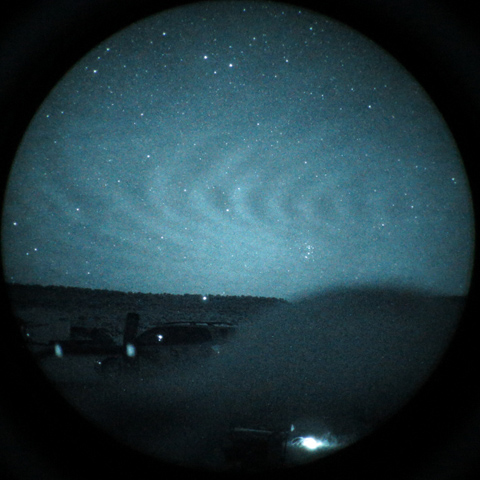 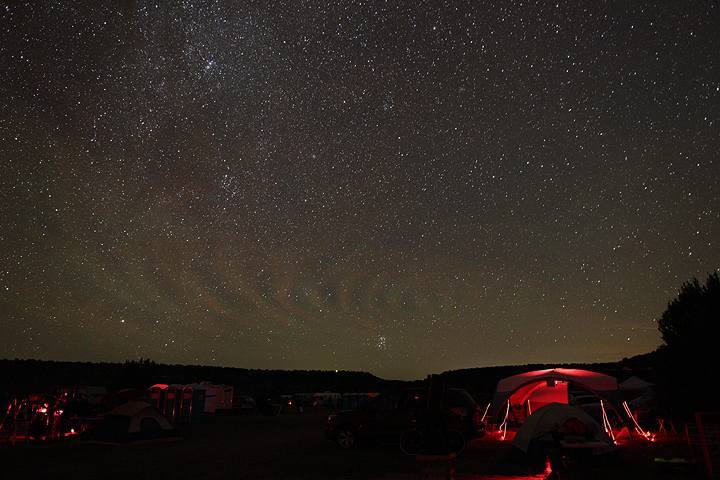 Friends, Food, a Bear, and Beer It was very nice to see that Tom and Jeannie Clark and the Browns, both from the New Mexico Astronomy Village, had made the trip up to Okie-Tex for the event. I did not know that they were coming, so it was a wonderful surprise. They have great skies at their homes, but Okie-Tex is slightly darker and has no light dome from Deming. It was great to see them, observe a bit, and catch up. Unfortunately my schedule this year didn't allow me time to visit NMAV as I have done in previous years, but I really would have enjoyed seeing Gary and Vandy and their latest projects, and beating Tom Clark at golf on his home course. Below, the Clarks and their dog Bear (very friendly) sit beside their motor home as darkness nears. 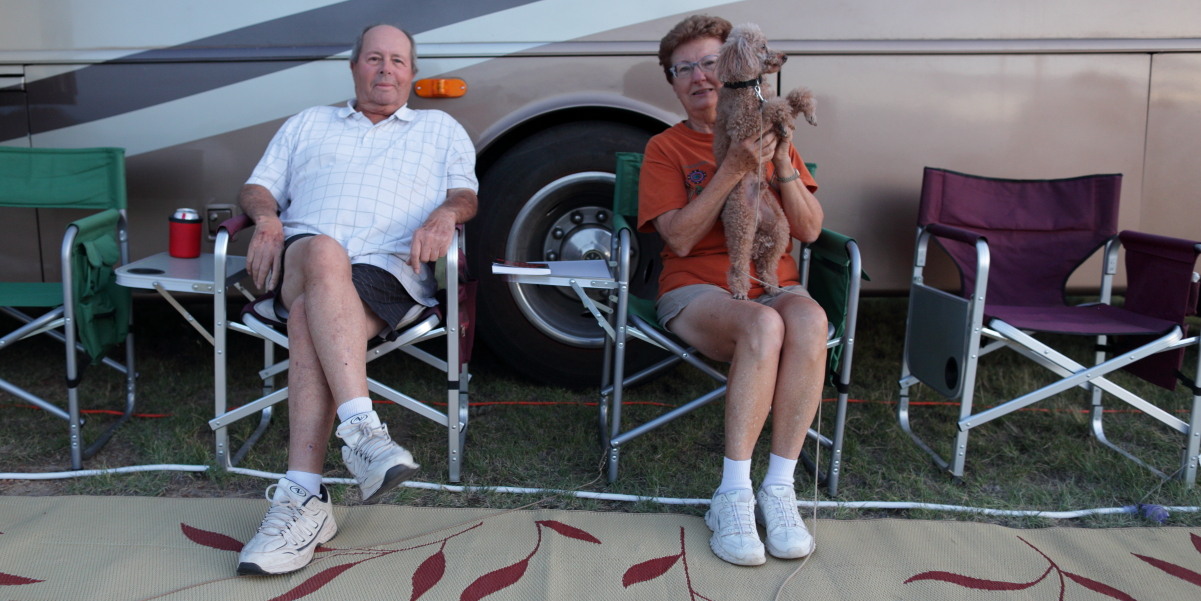 Kevin and his wife (below), also from NMAV, set up right next to the Clarks in their beautiful Airstream trailer. Their dog was a biter, so Bear won the favorite dog contest. However, they have a beautiful 22" f/3.3 Starstructure with my optics in it, so I'll forgive the dog for trying to bite my fingers. 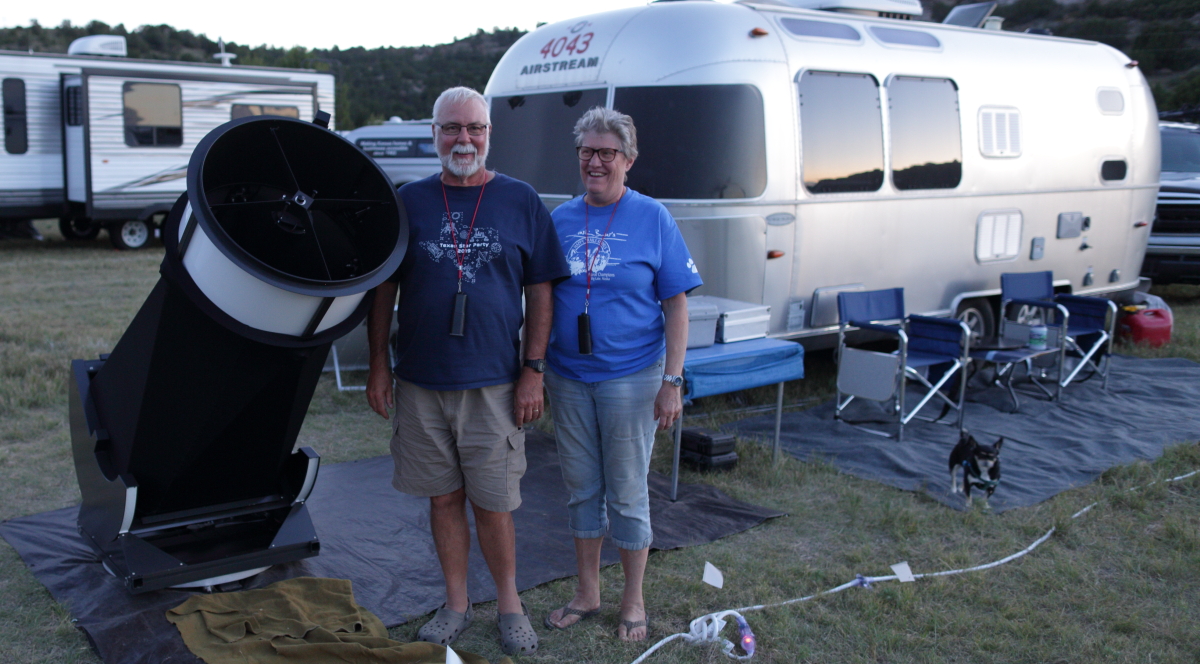 I know what you're wondering..... what about the beer tastings? Well, I won't disappoint you, and none of us were disappointed. In fact, despite the absence of some notorious bringers of superb brews, we had an amazing assortment of beverages from all over the United States and even some from other countries courtesy of world traveler and beer acquirer extraordinaire Allan Wade, whom I was fortunate to visit in April in Australia. He arrived on Monday and left just after me on Friday. Other members of our tasting group are rapidly gaining the skills to pick out outstanding beers at their local stores. I can honestly say that the only bad beer was brought by someone who tagged along. So, to clarify, the rules are: 1) Bring a couple of very good craft beers (something not advertised on TV) if you want to participate, and, 2) Be considerate when you pour - everyone needs to try some. 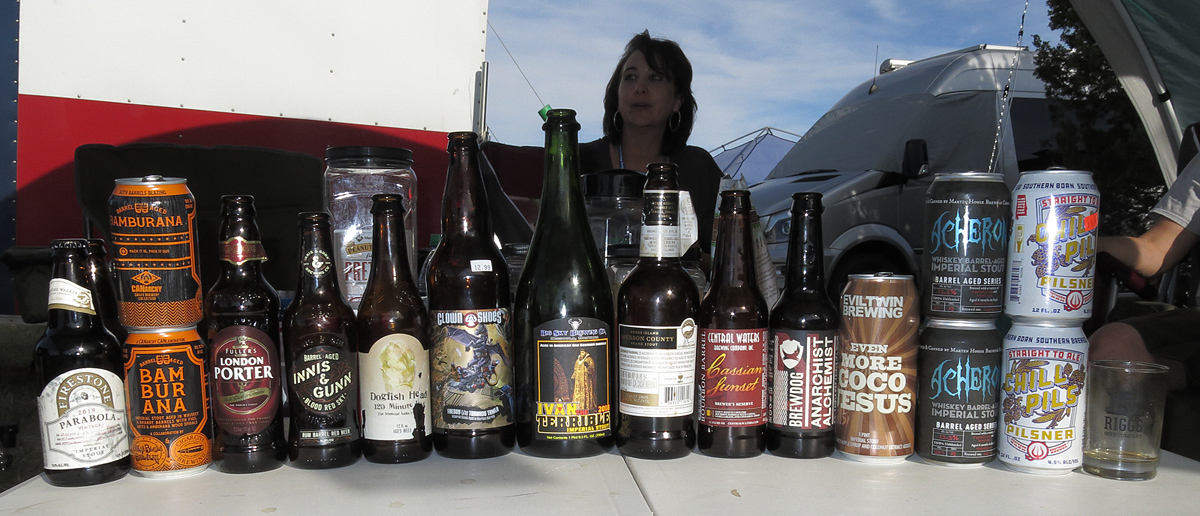 Above we see the empties from perhaps our most memorable tasting on Tuesday before a couple of attendees (who always bring superb contributions) had to leave. We always take a photo because then we can go back and look if there was something that stood out, or we can verify if we find one of them in our shopping or travels. Keep in mind that we had about 12 people attending, the tasting was over two hours, and we were observing later, so the amout of consumption was quite reasonable. Note the Parabola at left above, which I like to say is my official beer because that is what I usually make. Well, OK, I actually make paraboloids, not parabolas, but it's close enough for non-math terminology snobs. Tara is in the background, probably looking at some unfortunate non-beer tasters across the field. We enjoyed some great food during this week, and many pitched in to cook and help prepare food. Below at left is a great meal provided by Ed. I cooked the steaks on his grill while he provided all the food and did everything else. Below center, Ed is supplied with some beer for tasting by a kind soul while he cooks in his trailer. Ed also made a great spaghetti with meat sauce for a different night's dinner, Tara made chili that was so good that it ran out way too fast, and I made my Indian food crock pot for dinner on Tuesday, served in tortillas for an interesting variation. Below at right was an unusual sight - a weather balloon, as photographed with my Canon G15 through the eyepiece of Will's telescope. I noticed it on Monday morning in the western sky, and I doubt many others saw it then. However, by dark it had drifted to the southwest sky, and was quite conspicuous as the sun got lower and lit it up. On Tuesday it was in the southwest, and it was gone after that. I've never seen a balloon stay in the sky that long, and it certainly had an interesting design. 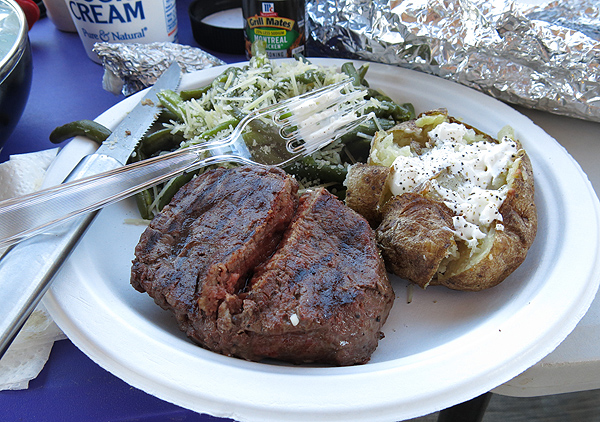 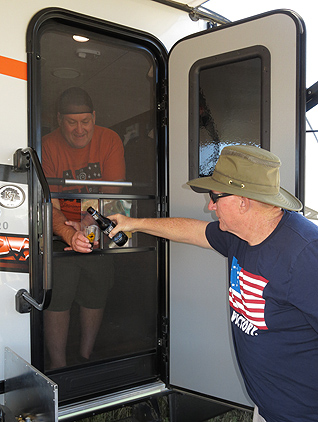 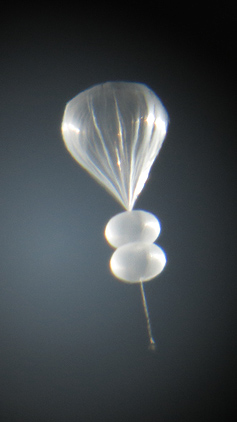 Next, below at left we have our group photo below at night with my 14.5" f/2.55 (Stubby), and at right a photo of Steve and his 14.7" New Moon Telescope with my quartz optics. The primary is 0.8" thick, and we were pleased with its performance, but it and most other telescopes were limited by the mediocre seeing for the three nights that Steve spent at the star party. Okie-Tex is known for darkness, transparency, and generally clear skies. The seeing can be pretty good, but it usually isn't. If you want good seeing, go to the Winter Star Party in the Florida Keys. These are two star parties that I attend each year, for those reasons. 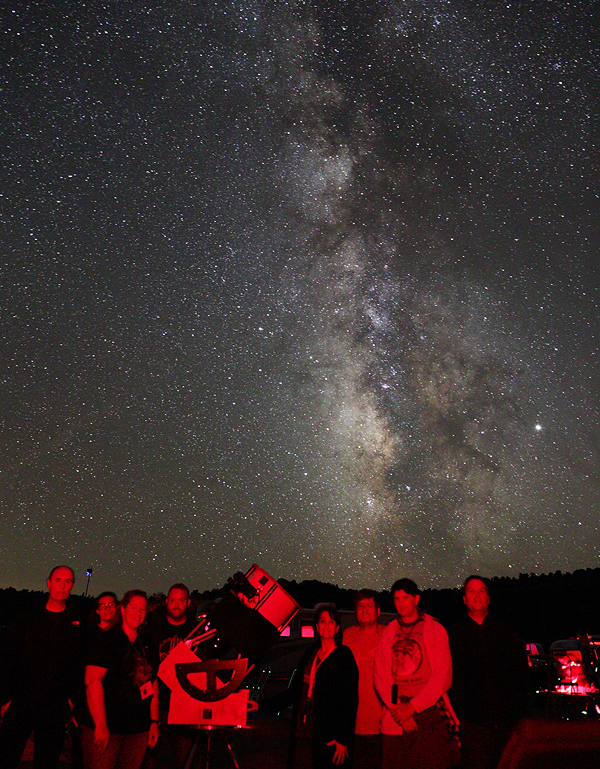 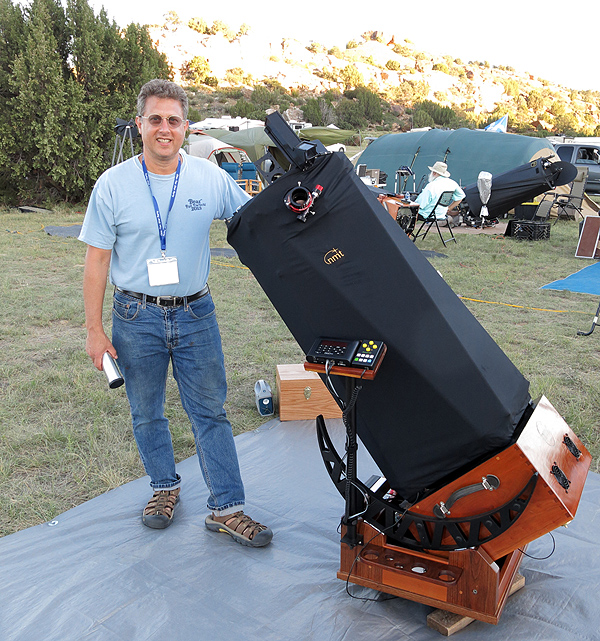 Finally, below is a photo of one of our meals, which we will do again next year, and perhaps expand a bit. From left to right (clockwise around the table) we have Tara, Steve, Brian, Allan, and Ed. I'm behind the camera, as usual, but I am in the group photo above at far right. I can only imagine what food we will come up for next year. Tara has ideas, y'all...... so look out. 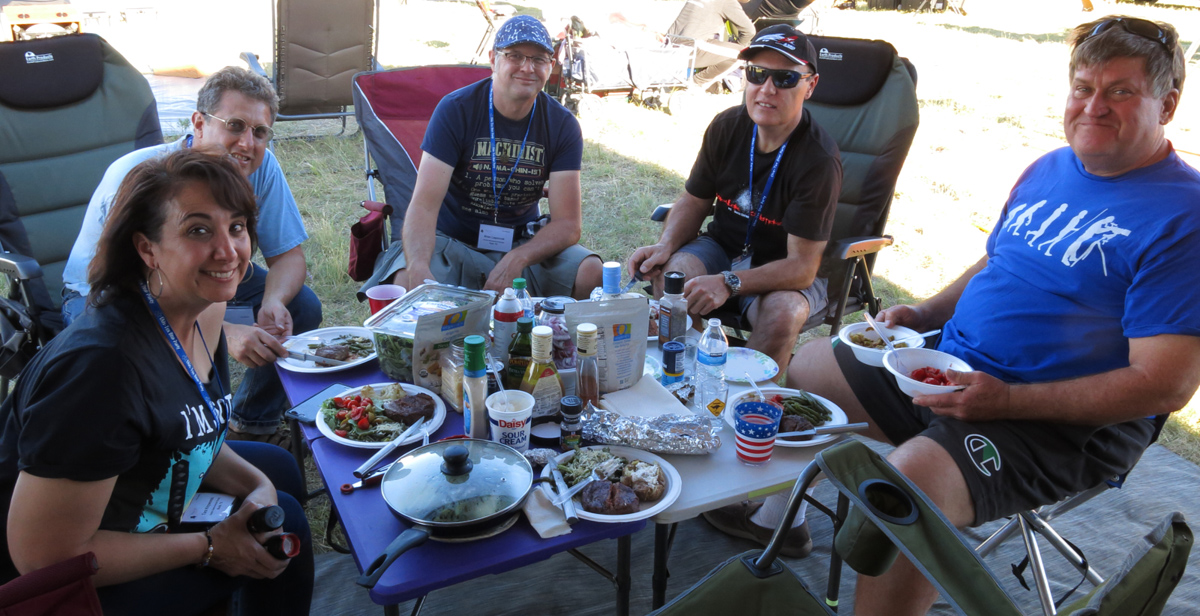 The weather held, and temperatures were pretty reasonable at night. After the first very windy night on Saturday, that breeze brought in some cooler air. It did get fairly cool on Sunday or Monday night, I believe, and that was the only night that required my down jacket (a.k.a. my non-serious winter coat) and long underwear. On most nights I just wore jeans, a fleece jacket, and I put on a down vest and a fleece hat when the wind kicked up or I started to get cool. I was pleasantly surprised how warm I stayed with the fleece/vest/hat combo on all but the one cooler night when I added the jacket over it all. One night towards the end of my stay was quite warm, and I didn't even need the vest. In short, the weather was great. I concluded my Okie-Tex 2019 by observing and tasting far too late into Thursday night and Friday morning. Rex brought over a superb beer to share, and that got it all started. Eventually most of the group joined us. Since I go to the Winter Star Party, when the winter sky rises at Okie-Tex, I tend to stop observing and think about getting some sleep. I am spoiled by the usually good conditions in the Keys in the middle of winter, and by seeing 10 stars in the Trapezium there. On this night we enjoyed the full group's company one last time since Allan and I were leaving Friday. After a very good sleep, I actually woke up early, had a rare Okie-Tex breakfast (usually I sleep too late), and headed for Los Alamos to visit friends. I made a quick stop in Albuquerque before returning home to get back to optical work and to finish outdoor projects before it gets too cold. I wish you clear skies, good food, good friends, good beer, good weather, and a reasonable winter. Well, Ed will have an unreasonable winter (it's already snowing in Montana!), but hopefully the rest of us won't. At least he has some good beer. -Mike Lockwood, Lockwood Custom Optics |